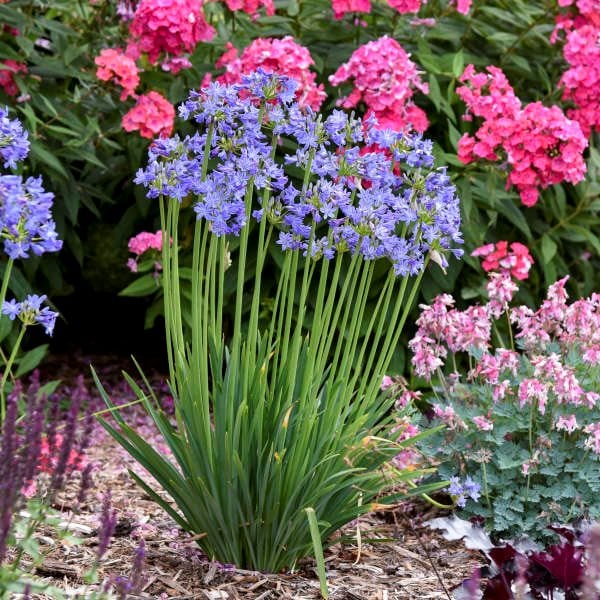How to Plant and Maintain Agapanthus in Your Yard
How to Plant and Maintain Agapanthus in Your Yard
Blog Article
Grasping the Art of Agapanthus Care: Crucial Actions for Healthy Growth and Dynamic Flowers
In the realm of horticulture, the growing of agapanthus stands as a fulfilling undertaking for those that look for to support these classy blooming plants. From picking the right range to grasping pruning techniques, the journey towards cultivating flourishing agapanthus plants is complex and holds the vital to unlocking the complete capacity of these botanical gems.

Choosing the Right Agapanthus Variety

When picking the appropriate Agapanthus variety for your yard, think about factors such as environment suitability, flower color, and growth behavior. Additionally, consider the environment in your area to make certain the Agapanthus range you select can thrive in your details problems. Recognizing the development behavior of different Agapanthus varieties is important for proper placement within your yard.
Ideal Planting Problems
Considering the ideal ecological demands is essential for effective Agapanthus cultivation. Agapanthus grows in well-draining dirt with a somewhat acidic to neutral pH degree. When planting, select an area that receives full sunlight to partial shade. In hotter climates, providing some mid-day color can avoid scorching of the leaves. Agapanthus plants are delicate to cool temperatures and must be protected from frost during cold weather.
To ensure healthy and balanced growth and lively blossoms, plant Agapanthus light bulbs at a deepness of concerning 2-4 inches and area them 8-12 inches apart. Mulching around the base of the plants assists maintain moisture and subdues weed development.
Watering and Fertilizing Tips
Preserving correct dampness levels and supplying vital nutrients are key elements in the treatment regimen for Agapanthus plants. When it comes to watering Agapanthus, it is vital to strike an equilibrium. These plants favor consistently damp dirt yet are vulnerable to root rot if overwatered.
Feeding Agapanthus is vital for advertising healthy development and respected blossoms. Use a balanced fertilizer, such as a 10-10-10 formula, in the early spring as new growth arises. By following these watering and fertilizing pointers, you can guarantee your Agapanthus plants flourish and produce dynamic, long-lasting blossoms.
Trimming Methods for Agapanthus
Trimming Agapanthus plants at the suitable times and with proper techniques is crucial for keeping their health and wellness and promoting ideal growth and blooming. The optimal time to prune Agapanthus is in late wintertime or very early spring prior to new development emerges.
Deadheading invested flowers view it now can likewise redirect the plant's power right into generating more blossoms visit their website rather than establishing seeds. If you want to accumulate seeds for propagation, leave some blossoms to dry and fully grown on the plant.
Keep in mind to make use of clean, sharp devices to make accurate cuts and minimize the risk of presenting conditions. Agapanthus. Regular pruning will certainly help maintain your Agapanthus looking neat and healthy while making certain an abundant display of attractive blooms
Managing Usual Pests and Diseases
After ensuring proper pruning methods for Agapanthus, it is crucial to deal with typical insects and conditions that can influence the health and vigor of these plants. One usual bug that influences Agapanthus is the Agapanthus gall midget.
In addition, Agapanthus plants can experience from root rot if they are grown in badly draining soil. By being watchful and taking prompt activity against insects and diseases, you can aid your Agapanthus plants grow and create dynamic blooms. Agapanthus.
:max_bytes(150000):strip_icc()/agapanthus-growing-guide-7368912_04-66a3f4cf245b4332b28954dd37c784f5.jpg)
Final Thought
To conclude, mastering the art of agapanthus care entails picking the right range, providing excellent planting problems, proper watering and fertilizing, proper trimming visit site techniques, and dealing with typical bugs and conditions. By following these necessary steps, you can guarantee healthy growth and lively blossoms for your agapanthus plants. Keep in mind to regularly monitor and maintain your plants to advertise their general health and long life.
To make certain healthy development and lively flowers, plant Agapanthus light bulbs at a deepness of concerning 2-4 inches and room them 8-12 inches apart. By adhering to these watering and feeding ideas, you can ensure your Agapanthus plants thrive and create dynamic, lasting blooms.
One usual insect that influences Agapanthus is the Agapanthus gall midget. Furthermore, Agapanthus plants can experience from origin rot if they are grown in badly draining pipes soil. By adhering to these essential steps, you can make certain healthy and balanced development and vibrant blooms for your agapanthus plants.
Report this page